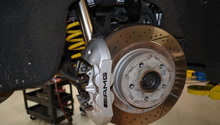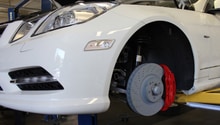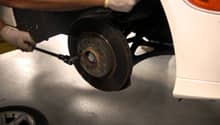Mercedes-Benz C-Class: Brake Modifications
The aftermarket has many different options for those wanting to gain more control over how their vehicle comes to a stop. Whether you are looking for a substantial increase in stopping power and brake responsiveness with a big brake kit, or a decrease in the amount of sound and dust over your current brake pads, this article will highlight the options available to you.
This article applies to the Mercedes-Benz C-Class w204 (2007-2014).
Brake modifications not only increase the performance of your vehicle, but may also decrease the unwanted effects of brake noise and a soft pedal feel. Stainless steel brake lines are made to increase pedal firmness and remove the risk of a rupture in the weaker rubber line. Larger and more efficient rotors can be purchased as well. These come in both slotted and drilled forms, allowing the rotor and brake pads to stay cooler longer. For those that are tired of cleaning the dust emitting from their brake pads, companies have developed purpose built pads that will no longer turn your wheels black. Road course racers and owners that strive higher-performance have the option to install big brake kits from companies that are reputed as best in the world of braking performance.
Braking Modifications
Your four options in braking modifications are brake pads, rotors, stainless steel brake lines, and big brake kits. For those wanting to keep with factory engineering, installing an AMG big brake kit is also an option.

Brake Pads
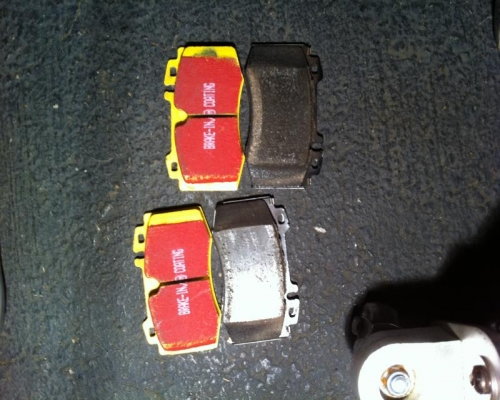
DIY Cost – $100-$200
Professional Cost – $200+ for labor
Skill Level – Moderate; experience with automotive braking systems is suggested.
Brake pads are designed to perform best in certain areas. Semi-metallic brake pads are harder in composition, and are commonly used with high-performance braking systems. Ceramic pads are known for the decreased amount of brake dust they emit, and the reduced noise levels. Recommended for its decrease in brake dust and reduced noise.
EBC makes brake pads that vary by color depending on the application. Red Stuff is most suited for those looking for minimal brake dust and low noise levels. Next up is Green Stuff, which is described as being a middle of the road brake pad in terms of performance and dust levels. For those with higher performance in mind, Yellow Stuff is their brake pad of choice.
Akebono makes a positively reviewed brake pad. Akebono is the world's largest supplier of OEM brake pads. They were the first to develop ceramic brake pads and offer a quality pad with similar characteristics to the factory brake pads without excessive dust levels.
The Porterfield R4-S is a competitive pad as well. Porterfield describes the pad as having lower dust and noise levels than factory, while also providing a reduced stopping distance and minimal brake fade.
Rotors

DIY Cost – $300-$400
Professional Cost – $200 for labor
Skill Level – Moderate; requires removal of the brake caliper. Experience with automotive braking systems is helpful.
Upgrading the factory rotors to a drilled and slotted type will produce more airflow through your brakes. This will help to eliminate brake fade and increase pad as well as rotor life. Recommended for its rotor life.
Cquence Performance Brake Parts makes a brake rotor that is both dimpled and slotted. These rotors meet or exceed OEM standards, and will work with the factory braking system.
Stainless Steel Brake Lines
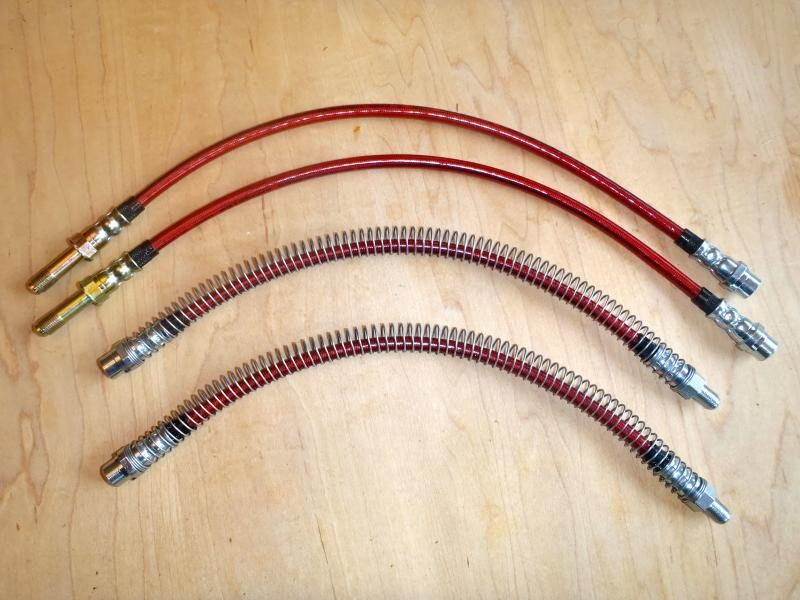
DIY Cost – $75-$125
Professional Cost – $200 for labor
Skill Level – Moderate; requires handling brake fluid and bleeding the brakes. Experience with automotive braking systems is helpful.
Stainless steel brake lines replace the weaker rubber line between your calipers and existing metal brake lines. Rubber lines are more prone to flexing, resulting in a soft brake pedal. Recommended for its durability.
Black Diamond makes a stainless steel brake line kit with a PTFE inner hose surrounded by a stainless steel braid for superior protection against corrosion. Black Diamond backs up its product with a lifetime warranty.
Big Brake Kit

DIY Cost – $1,000-$3,000
Professional Cost – $300-$400 for labor
Skill Level – Moderate; requires removal of the calipers and rotors. Experience with automotive braking systems is suggested.
Big brake kits offer large increases in performance over factory components by increasing the surface area between the pads and rotors using a greater number of caliper pistons. Improvements in stopping power, pedal responsiveness, and brake durability can all be found with a quality kit. You will need to make sure your wheel size is compatible with the big brake kit. Recommended for its increase in performance.
Alcon is a performance braking company with applications that include F1 and NASCAR racing. They offer a six piston caliper that includes a special alloy rotor designed to withstand the demands of racing.
Ksport also makes a six-piston caliper big brake kit. Their kit includes calipers made from aircraft quality billet metal with aluminum pistons and high temperature seals.
Ceika Performance offers a big brake kit that is customizable for the vehicle owner. Included are rotors that can be chosen in drilled or drilled and slotted forms (slotted is more designed for racing). Their kit can be used with many different brands of brake pad. The calipers can be custom made to work with any style of parking brake.
DCT performance has put together a complete AMG brake conversion kit for the w204 using all new factory components. Due to the increased caliper and rotor size, these brakes will not fit with some 18" and 19" wheels. The kit is priced at $3,600.
Pro Tip
Your brakes are only as good as their weakest link. Many people neglect their brake fluid. Mercedes-Benz recommends changing it bi-annually, but if you have an aggressive driving style or frequent to the back roads, shorter intervals are recommended. For German vehicles ATE Typ-200 DOT4, brake fluid is highly recommended.
Related Discussions
- AMG Brake Upgrade for W204 Sedans - MBWorld.org
- Best Type of Brake Pads to Buy - MBWorld.org
- High Performance Braking for Your Mercedes-Benz - MBWorld.org

